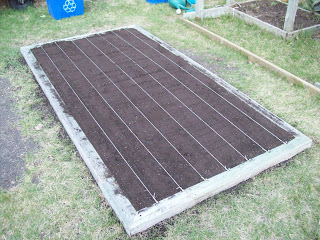On May 16th the weather was good, and with rain in the forecast the pressure was on to get the field seeded. After consulting a few websites we found out that planting the wheat about 3 1/2" deep would be good. Deciding how many rows to plant was a bigger problem. Some sources said the rows should be at least 10" apart. Others said it could be closer. In the end we decided to plant 7 rows at about 61/2" apart each. This is close, but weeding will be done by hand and access will be simple since it is a small field.
 |
| Digging the Middle Row |
Since the rows are so close together, we dug a row and then seeded it before we dug the next row. This took a bit of time, but this way we could focus on one row at a time. When we looked into how much seed to plant we found out about the "3 finger" method. The seed on 3 fingers is good for about 10 feet. We put in at least that much, and maybe a bit too much. A gardening friend suggested that if we have over seeded that we can always thin the rows once they emerge. Good idea!
 |
| Seeding the Middle Row |
Once the seed was in, we back-filled the row, and started over.
 |
| Covering the seed...six more rows to go! |
Seeding the field took quite a bit of time. Then again, we dug a 3 1/2" trench that was 56 ' long (7 rows x 8' each). Everyone took a turn with the seeding.
Once all seven rows were planted we added one more wheelbarrow full of soil to the top, since we expect the whole field might compact and sink a bit anyways.
Since we wanted to know where the wheat was under the ground, the last step for our seeding was to mark each row using a bit of string and a couple of roofing nails. It will be interesting to see if the wheat emerges where we expect it to pop up.
Now we wait for rain. The good news: this field is so small that we can water it or protect it if we need to. Rain is supposed to be on the way anyhow. To figure out how to get this far we watched a few YouTube videos that were helpful. Here are the links:
From Seed to Loaf (Part 1)
From Seed to Loaf (Part 2)
Wheat School: Evaluating Wheat Varieties
The Seed to Loaf videos are going to be very helpful as we move forward through the steps. The seeding rate recommended in the Seed to Loaf video is 15-20g of seed per m
2. 32 s.f. is about 3 m
2, so really we should have only used about 60 grams of seed in our little field. We ended up sowing about 207g of seed! We really over-did it...hopefully we can thin the rows once the plants emerge.
As we go we are getting advice from farmers that we know locally, but we are also looking for any help that any of you may be able to provide. Please feel free to post a comment to the blog if you have some ideas about our next steps. Right now we are trying to figure out how long it will take for us to see the first leaf. We have found the
Feekes Scale but we are not sure if it will apply for us, given how we have planted. Time will tell! It feels good to get to this point though. Hopefully the over-seeding won't be too much of a problem. Grow Wheat Grow!
That is all we know so far.




























